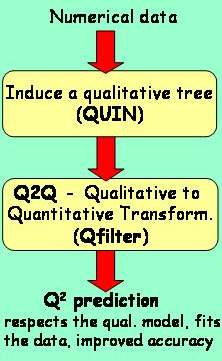![]() Dowload
QUIN and Qfilter with a graphical user interface (for Windows,
13Mb);
here is also a short
users-guide to QUIN (it will be updated soon)
Dowload
QUIN and Qfilter with a graphical user interface (for Windows,
13Mb);
here is also a short
users-guide to QUIN (it will be updated soon)
QUalitative INduction and Qualitative Trees
QUIN (QUalitative INduction) is a machine learning program that looks for qualitative
patterns in numerical data. QUIN expresses such qualitative patterns by
qualitative trees, that are similar to decision trees but have
monotonicity constraints in leaves. Bellow is an example of a qualitative tree induced
from a set of examples for the function Z=X2-X2 (denoted
by the red points on the right graph). The rightmost leaf, applying when attributes X
and Y are positive, says that Z is strictly increasing in its dependence on X
and strictly decreasing in its dependence on Y.
QUIN Applications and Qualitatively Faithful Numerical Learning
QUIN was applied in a number of domains, including reconstruction of human control strategies, qualitative reverse engineering of an industrial crane controller, qualitative system identification of a car wheel suspension system and others. Qualitative trees proved to provide a good insgiht into the modeled domain and enable (a possibly causal) explanation of relations among the variables.
 |
Apart from explanation, the induced qualitative trees can be
used to guide numerical regression. The resulting Q2
(Qualitatively faithful Quantitative) predictions are guaranteed to be
consistent with the induced qualitative model and are often considerably
more accurate than those obtained by the state-of-the-art numerical learning
methods (Q2 was compared to LWR-Locally Weighted
Regression, model and regression trees on datasets from UCI, Delve and
others). One method that enables such Q2 prediction is Qfilter. It is based on quadratic programming and uses a qualitative tree and (not necessary) predictions of a base-learner (for example LWR, regression or model tree) to give numerical predictions that are consistent with the qualitative tree. When using the predictions of a base-learner, the differences (improvements) in numerical accuracy of the base-learner and Q2 obviously come from the induced qualitative constraints.
|
Some Related Publications (see also my other publications)
ŠUC, Dorian, Machine Reconstruction of Human Control Strategies, IOS PRess, Amsterdam, The Netherlands, 2003. Based on the dissertation awarded by the 2001 ECCAI Artificial Intelligence Dissertation Award.
ŠUC, Dorian, VLADUŠIČ, Daniel, BRATKO, Ivan. Qualitatively faithful quantitative prediction. Proceedings of the eighteenth International Joint Conference on Artificial Intelligence, pp. 1052-1057, San Francisco: Morgan Kaufmann Publishers, 2003. Acapulco, August, 2003.
ŠUC, Dorian, BRATKO, Ivan. Improving numerical prediction with qualitative constraints. Machine learning : ECML 2003 : proceedings, (Lecture notes in computer science, Lecture notes in artificial intelligence, vol. 2837), , pp. 385-396. Berlin; Heidelberg; New York: Springer, cop. 2003.
BRATKO, Ivan, ŠUC, Dorian. Learning qualitative models. AI Magazine. vol 24, no. 4, pp. 107-119, 2003.